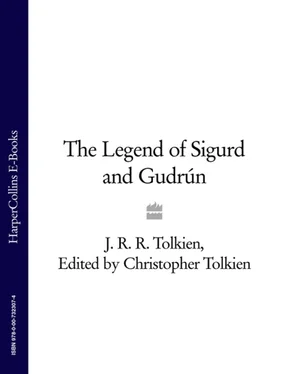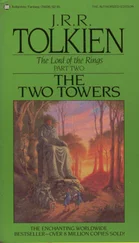J. Tolkien - The Legend of Sigurd and Gudrún
Здесь есть возможность читать онлайн «J. Tolkien - The Legend of Sigurd and Gudrún» — ознакомительный отрывок электронной книги совершенно бесплатно, а после прочтения отрывка купить полную версию. В некоторых случаях можно слушать аудио, скачать через торрент в формате fb2 и присутствует краткое содержание. Жанр: Старинная литература, на английском языке. Описание произведения, (предисловие) а так же отзывы посетителей доступны на портале библиотеки ЛибКат.
- Название:The Legend of Sigurd and Gudrún
- Автор:
- Жанр:
- Год:неизвестен
- ISBN:нет данных
- Рейтинг книги:5 / 5. Голосов: 1
-
Избранное:Добавить в избранное
- Отзывы:
-
Ваша оценка:
- 100
- 1
- 2
- 3
- 4
- 5
The Legend of Sigurd and Gudrún: краткое содержание, описание и аннотация
Предлагаем к чтению аннотацию, описание, краткое содержание или предисловие (зависит от того, что написал сам автор книги «The Legend of Sigurd and Gudrún»). Если вы не нашли необходимую информацию о книге — напишите в комментариях, мы постараемся отыскать её.
The Legend of Sigurd and Gudrún — читать онлайн ознакомительный отрывок
Ниже представлен текст книги, разбитый по страницам. Система сохранения места последней прочитанной страницы, позволяет с удобством читать онлайн бесплатно книгу «The Legend of Sigurd and Gudrún», без необходимости каждый раз заново искать на чём Вы остановились. Поставьте закладку, и сможете в любой момент перейти на страницу, на которой закончили чтение.
Интервал:
Закладка:
51 Grímhild’s offspring: the author of the Saga regarded Gotthorm ( Gottormr ) as a full brother of Gunnar and Högni, and had Gunnar say that they should persuade Gotthorm to do the deed, because he was young and had sworn no oath. My father here followed a tradition, found in the poem Hyndluljóð , that Gotthorm was the half-brother of Gunnar and Högni, being ‘Grímhild’s offspring’; Snorri Sturluson, also, says that Gotthorm was Gjúki’s stepson.
58–59 In the Saga, Gotthorm went twice to Sigurd’s chamber in the morning, but Sigurd looked at him, and Gotthorm dared not attack him on account of his piercing gaze; when he came the third time Sigurd was asleep.
67–69 These stanzas echo the concluding verses of the Brot , which does not extend to the death of Brynhild.
73 In the Saga, following Sigurðarkviða en skamma, Brynhild dying foretold all the later history of Gudrún; this has no place in the Lay.
77 Lines 5–7 are an exact repetition of lines 3–5 in III.13, where the ‘son’s son’ is Sinfjötli, except that the reading there is Völsung , not Völsungs. The plural form here is clear, but may nonetheless be erroneous. On the form Valhöllu see the note to III.13.
77–82 The concluding passage is of course peculiar to the Lay. With stanzas 79–81 cf. Upphaf , the opening section of the Lay, stanzas 11, 14–15.
77–78 In a fragmentary poem of the tenth century on the death of the ferocious Eirik Blood-axe, son of King Harold Fairhair and brother of Hákon the Good (see the note on V.54) there is a remarkable image of the coming of an ‘Ódin hero’ to Valhöll. The poem opens with Ódin declaring that he has had a dream in which he was preparing Valhöll to receive a company of the slain. There is a great noise of many men approaching the hall, and Ódin calls on the dead heroes Sigmund and Sinfjötli to rise up quickly and go to meet the dead king who is coming, saying that he believes it to be Eirik.
Sigmund says to Ódin: ‘Why do you hope for Eirik, rather than for other kings?’ And the god replies: ‘Because he has reddened his sword in many lands.’
Then Sigmund asks: ‘Why have you robbed him of victory, when you knew him to be brave?’ And Ódin answers: ‘Because it cannot be clearly known. . .’ – and then (at any rate as the text stands) he breaks off, and concludes: ‘The grey wolf is gazing at the dwellings of the Gods’ (see the commentary on the Upphaf (‘Beginning’), pp.185–86.
Note on Brynhild
In what follows I set out, with minor editing, the content of some notes of my father’s, written very rapidly in soft pencil and difficult to read, on his interpretation of the tangled and contradictory narratives that constitute the tragedy of Sigurd and Brynhild, Gunnar and Gudrún. I will repeat here what I have said in my Foreword, that there is nothing in these or any other notes for his lectures on Old Norse literature that bears on the question of whether he had written, or intended to write, poems on the subject of the Völsung legend; but that views expressed in the lectures may illuminate, naturally enough, his treatment of the sources in his Lays.
In my commentary on the last part of the Lay I referred (p.234) to my father’s belief that the fragment of a Sigurd lay known as the Brot, with which the Codex Regius takes up again after the lacuna, is the conclusion of ‘an ancient, terse, poem, concentrated chiefly on the Brynhild tragedy’. For this poem he used in his notes the title Sigurðarkviða en forna , ‘the Old Lay of Sigurd’. In notes for a lecture on the content of the lacuna he suggested (following the great scholar Andreas Heusler) that the poem probably began with Sigurd’s coming to the halls of Gjúki, and his reception; his oath of brotherhood with the king’s sons; and his wedding with Gudrún: all this probably brief and without reference to Sigurd’s previous knowledge of Brynhild . He proposed that the chief elements of the conception of Brynhild in that poem were these.
(1) A semi-magical personage, ultimately derived from a Valkyrie legend.
(2) She surrounded herself with a wall of flame, and vowed only to wed the hero who rode it – intending it to be Sigurd.
(3) The wall of flame is ridden by Sigurd, but under the appearance of Gunnar. The oath holds her. She comforts herself with the thought of Gunnar’s deed.
(4) Her comfort fails and her pride is mortally wounded when she discovers that it was Sigurd after all who rode the flame: in addition she has been tricked into breaking her oath to wed the actual rider.
(5) Her vengeance takes this form: she cannot have Sigurd now, and therefore she will destroy him (and so mortally wound Gudrún, the natural object of her hate); but she will by this very act avenge herself on Gunnar by involving him in a dreadful oath-breaking – so that after all is over, Sigurd dead, and she about to follow, she can turn and say, ‘Sigurd is pure of all such vileness, you Gunnar alone are shamed’ [this is the end of the Brot, echoed in stanzas IX.67–69 in the Lay].
(6) To do this she lies terribly against Sigurd and herself. She accuses him of broken faith when he lay in her bed after the riding of the flame. This was her only means of getting Gunnar to slay him [see stanzas IX. 43, 46, and 49 of the Lay]. Later she reveals the truth [stanza 68, lines 5–8].
That is why Áslaug is such a fatal addition in the Saga, even if she was begotten upon the mountain-top, not at the second riding of the flame (see p.232).
I think that we should accept (he wrote) such a conception for the poem, of which the twenty stanzas of the Brot are all that are left, and for one of the oldest lines of tradition. The resolution of the Brynhild-Valkyrie difficulty does not lie in the assumption that one was mortal (Brynhild) and the other a Valkyrie from an older ‘myth’, which later became confused. The solution, I think, is that the Valkyrie is the one essential part of the whole story, which is always present. [In a separate note my father wrote: ‘Brynhild cannot be a “human” character mythicized (or confused with a Valkyrie Sigrdrífa). She is a Valkyrie humanized.’]
But she was treated in at least two different ways. There was the mountain-top awakening of the Ódin-enchanted Valkyrie (perhaps the more specifically Scandinavian conception and therefore the later, since the story was not originally Scandinavian). There was also the proud princess tricked by her own stratagem (when Sigurd rode the fire but in the form of Gunnar) – the more southern one. That the lost poem that ends in the Brot represented this older ‘more southern version’ is probably borne out by the important point in which it does agree with the non-Scandinavian versions, namely that Sigurd was murdered out of doors in a wood and that Högni had a part in it (in the Brot itself Gudrún is shown standing at the doors of the hall as the brothers ride back).
It is significant that the compiler of the Codex Regius entered a note about this since it clearly puzzled him and his contemporaries (see p.238, note to stanzas 51–64). He notes that the Old Lay of Gudrún says the same – in this case, that Sigurd was slain at the Thing (the council place); and he is aware that this is the ‘southern’ version ( þyðvestur menn , German men). The other story, the slaying of Sigurd in bed in Gudrún’s arms, in keeping with the Norse tendency to the personal, and to the concentration of action in time and place, is represented in Sigurðarkviða en skamma , the extant Sigurd lay (see p.234), and this is the version followed (without comment) in the Saga, and in the Lay (see p.238).
Читать дальшеИнтервал:
Закладка:
Похожие книги на «The Legend of Sigurd and Gudrún»
Представляем Вашему вниманию похожие книги на «The Legend of Sigurd and Gudrún» списком для выбора. Мы отобрали схожую по названию и смыслу литературу в надежде предоставить читателям больше вариантов отыскать новые, интересные, ещё непрочитанные произведения.
Обсуждение, отзывы о книге «The Legend of Sigurd and Gudrún» и просто собственные мнения читателей. Оставьте ваши комментарии, напишите, что Вы думаете о произведении, его смысле или главных героях. Укажите что конкретно понравилось, а что нет, и почему Вы так считаете.












